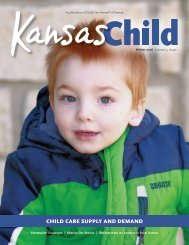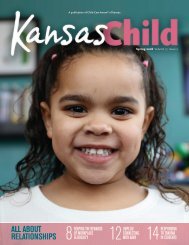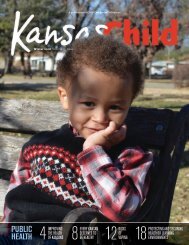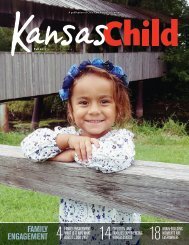2019 Fall Kansas Child
You also want an ePaper? Increase the reach of your titles
YUMPU automatically turns print PDFs into web optimized ePapers that Google loves.
FINDING
MY WAY
TO THE
BEST ME
BY ALICE EBERHART-WRIGHT
My shelves are
lined with the children’s
books I have
collected for the past
50 years. And still I
find new ones that
are so exciting I can’t
wait to share them. Book Nook is longer
than usual this time to share a set of books
developed in our own state by people who
knew how to create simple, powerful stories
about inclusion.
Kansas authors, Jo Meserve Mach and
Vera Lynne Stroup-Rentier have used their
occupational therapy and special education
backgrounds to write six books that are true
stories of inclusion and self-determination.
Photographs done by Mary Birdsell make
the families in these stories come to life.
Called the Finding My Way series, they are
geared for reading to children from ages 4 to
8. Each book features a child with a disability
living in a family and experiencing all the
things every child should be able to experience.
Their disability is never mentioned, but
the back of the book has a single sentence
telling the reader the name of the disability.
I see these books as being key to have
in collections for anyone who works with
families. They might also be important for
child care and teacher training. A last selling
point: They are so simple, early readers will
be able to read them for themselves.
I Want to Be Like Poppin’ Joe is about
Dylan, who finds a mentor called Poppin’
Joe. Dylan has Down Syndrome. Poppin’ Joe
has both Down Syndrome and Autism. Joe
learned to make popcorn and sell it because
his dad carefully taught him every step in
the process – a task chosen based on Joe’s
interests. Dylan’s dad follows Dylan’s interests
by joining with him outside, doing all
the things involved in yard work: digging,
planting, counting, etc. For children, this is
work, not play, and they love it. (We have
to teach many adults that children’s play
is much more than play.) Dylan can feel a
sense of pride as a parent or teacher who
reads the book comparing what Poppin’ Joe
did and what Dylan can do, just like Joe. The
My shelves are lined
with the children’s books
I have collected for the
past 50 years.
cover picture of Dylan and Joe studying one
another is delightful. Find role models who
fit the situation, just like sports heroes and
children loving to play sports.
Kaitlyn Wants to See Ducks will make
many of us smile as we think of strongwilled
children. Kaitlyn might have Down
syndrome but she knows what she wants. In
this book she wants only to see the ducks
at the zoo. However, her loving family helps
her experience new animals on the way to
the ducks. After all, there are 5 people in
the family and they all have wishes. Balancing
the needs of one child vs. other children
both at home and in school takes patience
and new strategies. The authors capture in
words and pictures all the strategies Kaitlyn
uses to try to make people do what she
wants. The photos capture how to stay calm
and soft spoken, riding a child on shoulders,
having more than one adult to maintain a
united front, and finally deciding that the
crying stage is indicating it’s time to go see
the ducks. Everyone is happy. (I read this
simple little story to my great-niece, 4-year-old
Kat, and her worn-out mother, Jill, and loved
the opportunity to make my voice demand, beg,
whine, and cry. This was their favorite book.)
Marco and I Want to Play Ball is the
story of 2 cousins. Isiah might have spina
bifida, but that doesn’t get in the way of the
two boys playing ball with Grandpa. Grandpa
might be old and think that he doesn’t have
enough energy to deal with two little boys, but
how can he resist when he remembers his own
love of baseball? Soon he is out in the back
yard totally engaged in the magic of throwing,
catching, and batting a ball without all the
rules and competition of a formal game.
He is engaged. He watches the boys and
gives them just the right coaching: stand up
tall, keep your eyes on the ball, don’t throw
the bat, try again. They are learning about
love, about sharing, about having a goal and
eventually making it. They are also learning
to juggle teasing and supporting one another,
such as how to problem solve when
the ball gets stuck in a tree. We all learn
20
A Publication of Child Care Aware ® of Kansas
















